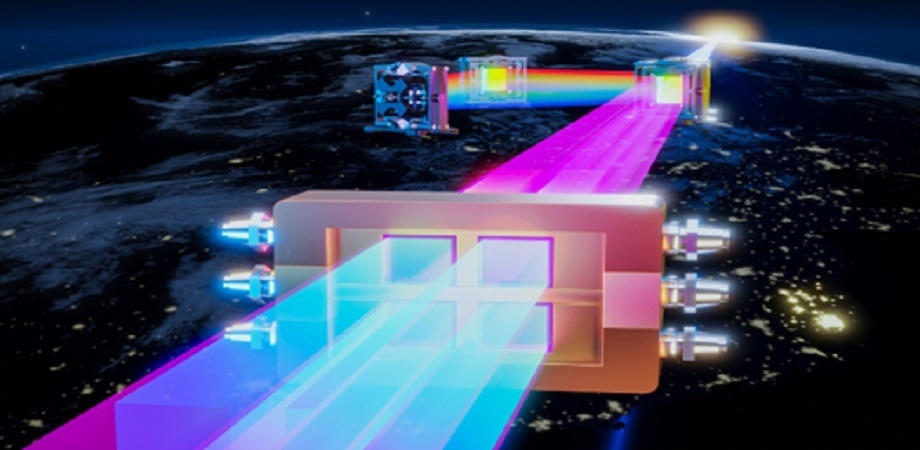Applications for ultra-intense ultrashort lasers are numerous and include industrial service, health care, national security, and fundamental physics. Such lasers have emerged as an important research tool in strong-field laser physics in fundamental physics, particularly for laser-driven radiation sources, laser particle acceleration, vacuum quantum electrodynamics, and related topics.

Coherently tiled titanium:sapphire laser amplification. Image Credit: Yuxin Leng
The shift in gain medium for large-aperture lasers from “neodymium-doped glass” to “titanium:sapphire crystal” is responsible for the dramatic increase in peak laser power, from the 1-petawatt “Nova” in 1996 to the 10-petawatt “Shanghai Super-intense Ultrafast Laser Facility” (SULF) and the 10-petawatt “Extreme Light Infrastructure – Nuclear Physics” (ELI-NP) in 2019. This change caused high-energy laser pulse durations to drop from around 500 femtoseconds (fs) to roughly 25 fs.
Nonetheless, 10-petawatt lasers seem to be the maximum power for ultra-intense, ultrashort titanium-sapphire lasers. Currently, researchers often give up on titanium:sapphire chirped pulse amplification in favor of optical parametric chirped pulse amplification, which is based on deuterated potassium dihydrogen phosphate nonlinear crystals, for 10- to 100-petawatt development plans.
That technique will be extremely difficult to realize and use for the next 10–100 petawatt lasers because of its low pump–to–signal conversion efficiency and poor spatiotemporal–spectral–energy stability.
However, as a well-developed technology that has successfully achieved two 10-petawatt lasers in China and Europe, titanium:sapphire chirped pulse amplification still has a lot of potential for the next stage of development of ultra-intense ultrashort lasers.
A broadband laser gain medium of the energy-level type is titanium:sapphire crystal. The energy storage process is completed when the pump pulse is absorbed and builds up a population inversion between the upper and lower energy levels.
A broadband laser gain medium of the energy-level type is titanium:sapphire crystal. The energy storage process is completed when the pump pulse is absorbed and builds up a population inversion between the upper and lower energy levels.
The energy contained in the titanium:sapphire crystal is retrieved for laser signal amplification after the signal pulse passes through it many times. On the other hand, with transverse parasitic lasing, the signal laser amplification is diminished and the stored energy is consumed by an enhanced spontaneous emission noise along the crystal width.
At the moment, titanium:sapphire crystals’ maximum aperture is limited to 10-petawatt lasers. Because strong transverse parasitic lasing develops exponentially with titanium:sapphire crystal size, laser amplification is still not achievable even with bigger titanium:sapphire crystals.
Researchers have developed a novel method for addressing this problem that entails cogently tiling many titanium:sapphire crystals together. This technique, as described in Advanced Photonics Nexus, effectively increases the aperture diameter of the entire tiled titanium:sapphire crystal and truncates the transverse parasitic lasing within each tiling crystal, breaking through the current 10-petawatt limit on the ultra-intense ultrashort lasers.
The tiled titanium:sapphire laser amplification was successfully demonstrated in our 100-terawatt (i.e., 0.1-petawatt) laser system. We achieved near-ideal laser amplification using this technology, including high conversion efficiencies, stable energies, broadband spectra, short pulses, and small focal spots.
Yuxin Leng. Study Corresponding Author, Shanghai Institute of Optics and Fine Mechanics
Coherently tiled titanium:sapphire laser amplification, according to Leng’s team, offers a rather simple and affordable means of exceeding the existing 10-petawatt limit.
Leng further added, “By adding a 2×2 coherently tiled titanium:sapphire high-energy laser amplifier in China’s SULF or EU’s ELI-NP, the current 10-petawatt can be further increased to 40-petawatt and the focused peak intensity can be increased by nearly 10 times or more.”
The technique is expected to improve ultra-intense ultrashort lasers’ experimental potential for strong-field laser physics.
Journal Reference
Liu, Y., et. al. (2023) Coherently tiled Ti:sapphire laser amplification: a way to break the 10 petawatt limit on current ultraintense lasers. Advanced Photonics Nexus. doi:10.1117/1.APN.2.6.066009